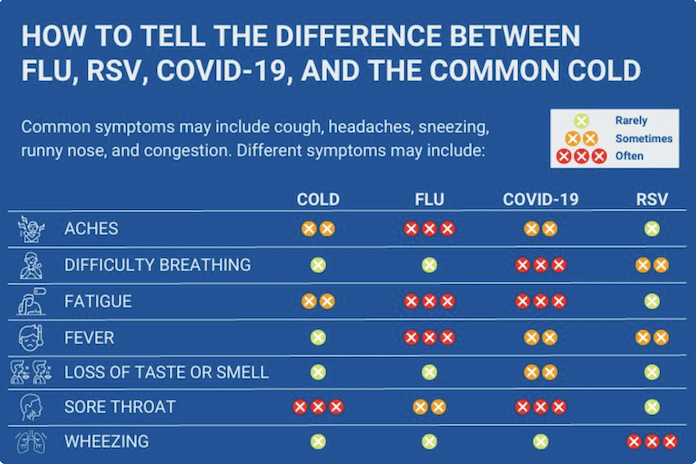Respiratory risks rise

With Christmas and New Years gatherings passing by or still coming, a heavy flu season joined by an uptick in other respiratory illnesses could spoil the holidays for many.
At the state level, a recent article from Capitol News Illinois titled “Public health officials urge caution around respiratory illness” notes the Illinois Department of Public Health has warned county health departments and hospitals around the state to advise the use of masks and other measures to prevent the spread of COVID and other viruses.
As the article further notes, an uptick in COVID hospitalizations in the state is largely localized to a few pockets including a stretch of central to western counties from Christian to McDonough as well as Kankakee and Iroquois counties to the eastern part of the state.
This is according to data from the Centers for Disease Control, which has remained largely the same since the article was published Dec. 19.
Locally, CDC data indicates a low rate of COVID hospitalizations for Monroe, Randolph and St. Clair counties with 6.3 new COVID hospitalizations per 100,000 population over the past week.
As the article notes, COVID is not the only concern among IDPH as the agency is also tracking hospital admissions due to influenza and respiratory syncytial virus.
Monroe County Health Department Administrator John Wagner spoke in regard to COVID and RSV, saying the former has been relatively steady over the last month with a slight increase at the start of December.
RSV has been similar, with a small surge in daycares at the top of the month without much of an increase lately, though Wagner said the respiratory illnesses could see new activity in the wake of holiday gatherings.
“Have not seen anything recently, no recent uptick,” Wagner said Tuesday. “Now we’ll wait and see. Give me a call in a week or a week and a half after the holidays and then we’ll see what’s going on then with everybody visiting and stuff like that.”
Asked how this year compares to the 2022 flu season, Wagner said there isn’t much difference as of yet.
“It’s about the same. RSV seems to be a little more prevalent this year than last year,” Wagner said. “As far as COVID and everything, it seems to be remaining about the same.”
Wagner noted, as he has in the past, that home testing and reporting changes make it somewhat more difficult to accurately gauge the state of COVID cases.
Wagner added much of the concern in regard to COVID lies with high-risk populations, though they are inherently at a greater risk as COVID spreads through the general public.
Offering additional perspective was Jason Newland, a pediatric infectious diseases physician with St. Louis Children’s Hospital and Washington University.
Newland said this latest respiratory illness season was comparable to years prior to the COVID pandemic as far as RSV and flu, with COVID serving as a new player.
He explained that he’s seen a typical uptick in RSV over the last few months with its regular mid-October appearance.
The flu typically comes around this time of December with an increase in cases seen through the coming week.
Newland added that comparing this year and the previous flu seasons, last year’s respiratory illnesses saw a surge in cases much earlier than usual, though, as far as the amount of cases, winter is always busy for him.
“In children’s hospitals around this time, our hospitals become extremely full, and it’s driven by respiratory illnesses,” Newland said. “One of the big ones is RSV, and RSV impacts those infants, especially infants less than six months of age. The younger you are, the greater risk you are of being hospitalized, and not only being just in the hospital but in the intensive care unit.”
The unique aspect of this year Newland pointed out was less to do with greater illnesses and more concerning additional prevention options with vaccines and immunizations.
He noted an RSV vaccine for both elderly individuals – who can also be very susceptible to infection – and pregnant mothers which allow their babies to have antibodies for the virus for their first few months when they’re especially vulnerable.
Newland also mentioned an immunization option for infants, explaining that a vaccine is an active process where the body learns to respond to a disease and make the antibodies necessary to fight it where an immunization is a passive process in which antibodies are injected which offer protection but will eventually fade.
He expressed concerns about vaccine hesitancy, recalling what has happened in recent years with the COVID vaccine, though he also spoke hopefully about parents following the recommended immunization schedule to help keep their babies healthy.
Along with vaccine and immunization recommendations, Newland pointed to the typical respiratory virus prevention methods.
“We all learned during the pandemic what will protect you from getting these colds,” Newland said. “One is a mask. Wear a mask. I was on a plane today, I wore a mask because I heard a lot of people coughing. Wash our hands… And if you have a cold, and you’re gonna go visit, don’t touch the baby. Keep the baby away. Let the little infant who could be at the greatest risk of being in the hospital because of a cold like RSV, that’s the person to protect.”
To contact the Monroe County Health Department for flu and COVID vaccine options, call 618-939-3871.






